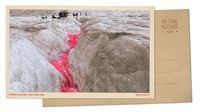High in the Swiss Alps, where the air is crisp and the horizon is dominated by jagged peaks, a group of scientists and journalists gathered on a brisk August day in 2025 for an unusual experiment. Their destination: the Rhône Glacier, a storied river of ice that has become a symbol of the planet’s changing climate. On this day, however, the glacier would be marked by a vivid streak of bubblegum pink—a bold, visual reminder of how rapidly it is vanishing.
The scene was almost surreal. According to NPR, as the team from ETH Zurich, Switzerland’s renowned public university, prepared their equipment, a lighthearted debate broke out over which color dye should be used for the demonstration. “What do you think would look better: pink or green?” one scientist asked. Pink won out, and with a nod, the scientist produced a bottle of the chosen dye. With a flourish, they released it at the top of the Rhône Glacier, sending a rivulet of water cascading down the ice in a bright-pink stream.
But this was no mere spectacle. The pink dye served a practical purpose: it was a visual aid for the journalists and scientists measuring the pace at which water now rushes off the glacier. And the result was sobering. The flow of meltwater was faster than ever, underscoring the urgent reality of glacial retreat in the Alps. As NPR’s correspondent described, the group found themselves “surrounded by a 360-degree aural landscape of running water,” with some currents gurgling from beneath the very ice they gingerly trekked across.
Walking on the glacier was not without its perils. The team moved cautiously, testing each step with care to avoid the dozens of massive cracks—crevasses—that sliced through the ancient ice. The packing list for the trip, emailed in advance, included a stark reminder of the risks: “Ice pick (Eispickel) in case of a slip into a crevasse.” Fortunately, no one had to use an Eispickel that day. Yet the presence of such tools was a constant reminder of the glacier’s treacherous and unpredictable terrain.
For the scientists from ETH Zurich, measuring the glacier’s meltwater is a vital part of understanding the broader impacts of climate change. The Rhône Glacier, one of the largest in the Alps, has been shrinking for decades, and its retreat has accelerated in recent years. The pink dye, while playful in appearance, highlighted a far more serious reality: the glacier is disappearing at a pace that alarms even seasoned researchers.
As the team poured the bottle of pink solution into a glacial stream, cameras clicked and whirred to capture the moment. The resulting scene was, in the words of NPR’s reporter, “an even more unnatural display than the quickly vanishing glacier itself.” For a brief time, the bright-pink stream snaked its way down the ice, a vivid contrast to the stark whites and blues of the alpine landscape. It was a striking visual metaphor for the unnatural speed at which the glacier is melting.
While the experiment may have been the “least scientific test carried out this day,” as NPR put it, its impact was undeniable. The pink dye made the invisible visible, drawing attention to the forces at work beneath the surface. It also served as a powerful communication tool, helping journalists convey the urgency of the situation to their audiences around the world.
“The result: Faster than ever,” the report noted. The sound of running water, once a gentle background hum, has become a constant roar on the glacier. Some of these currents flow from beneath the ice, carving new channels and widening existing cracks. For those present, the experience was both awe-inspiring and unsettling—a reminder of nature’s power, but also its fragility in the face of human-driven change.
As the day unfolded, the team took turns leaping over crevasses, each step a careful negotiation with the unpredictable terrain. The journalists, too, found themselves fully immersed in the experience—not just as observers, but as participants in a story that is still being written. The pink stream, though temporary, left a lasting impression on everyone present.
Beyond the Rhône Glacier, the Far-Flung Postcards series from NPR offers glimpses into other corners of the world: dolphins swimming alongside a migrant rescue ship in the Mediterranean, President Zelenskyy strolling through the streets of Kyiv, vibrant art emerging from discarded objects in Guatemala, and more than a thousand cats roaming the American University of Beirut. Each postcard is a window into a unique moment, but the story of the melting glacier stands out for its urgency and global significance.
The experiment on the Rhône Glacier is part of a larger effort by scientists to document and understand the rapid changes occurring in the world’s glaciers. Glaciers are often called the “canaries in the coal mine” of climate change—early warning systems that signal trouble ahead. Their retreat affects not just local landscapes, but also global sea levels, freshwater supplies, and weather patterns.
For Switzerland, the stakes are particularly high. The country’s iconic glaciers draw tourists from around the world and provide crucial water resources for agriculture, hydropower, and drinking water. As the glaciers shrink, communities downstream face new challenges, from reduced water availability to increased risk of floods and landslides.
The use of pink dye on the Rhône Glacier may have been a fleeting spectacle, but its message endures. The glacier’s rapid melt is not just a scientific curiosity—it’s a warning that demands attention. As the world grapples with the challenges of climate change, moments like these serve as powerful reminders of what is at stake.
By the end of the day, the pink stream had faded, washed away by the relentless flow of meltwater. But for the scientists, journalists, and anyone who witnessed the spectacle—either in person or through NPR’s reporting—the memory lingers. The Rhône Glacier, once a symbol of permanence and endurance, now stands as a testament to the speed and scale of change in the natural world.
As the sun set over the Alps, casting long shadows across the ice, the team packed up their equipment and made their way back down the mountain. The glacier, scarred by cracks and streaked with the last traces of pink, continued its slow retreat. For those who care about the future of our planet, the message was clear: time is running out, and the evidence is written in the rivers of color that now flow where ice once stood.




